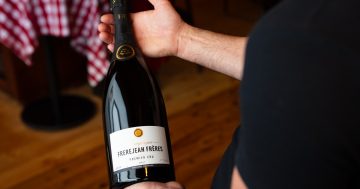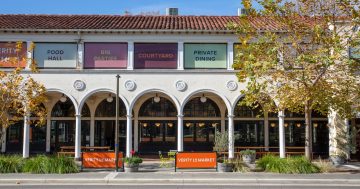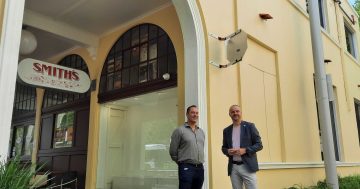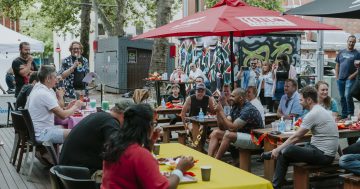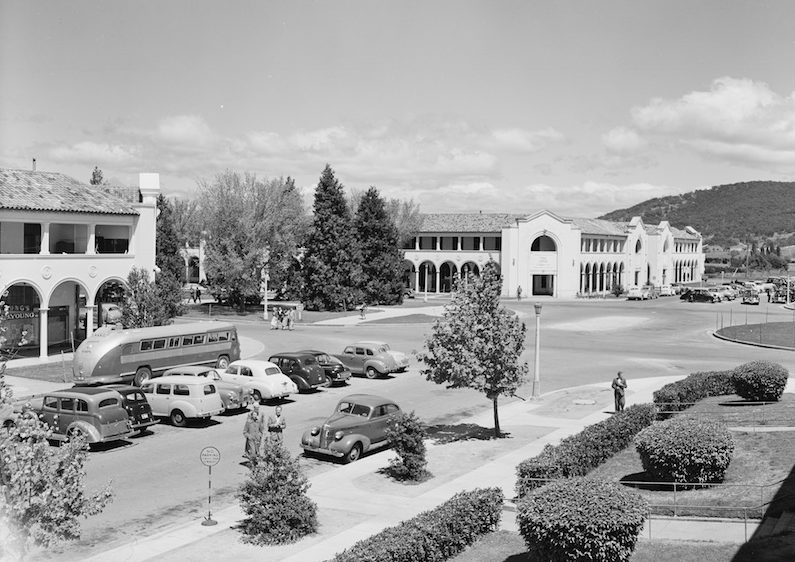
The Sydney and Melbourne buildings viewed from London Circuit in 1952. Photo: National Archives of Australia.
After-school milkshakes, scones and cakes. The Blue Moon Café in Canberra’s Civic Centre was a social hub in the city’s early days. Opened by Richard Prowse in 1928, the Blue Moon Café was one of the first businesses in the designated commercial area of the Sydney and Melbourne Buildings.
The café was an old-time tearoom, and Mrs Prowse was famous for her cooking. Advertising ‘meals at all hours’, she also catered for numerous social gatherings, engagement parties and the occasional wedding.
Australian architect Sir John Sulman (1849–1934) designed the Sydney and Melbourne Buildings in the 1920s. His colonnade design was influenced by the renaissance style of the Foundling Hospital in Florence, built in the 1420s.
The construction of the buildings was unique in that they were built in individual sections, like Sydney’s terrace houses. In 1924 leases for the individual sections began to be sold, with the purchasers contracted to construct their part of the building according to design specifications. Some of the leases were purchased for commercial premises. Some were purchased for banks and offices, and some were purchased as investments, with the intention of selling the lease at a later time for a profit.
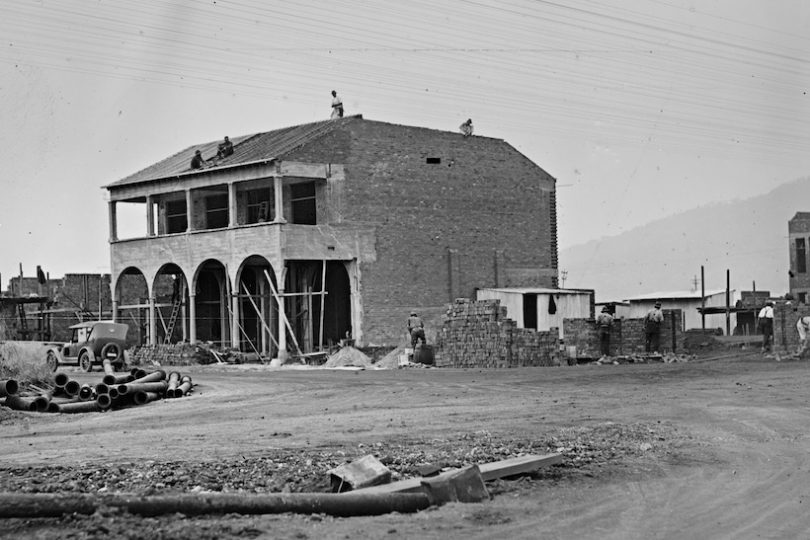
Section of Sydney Building under construction in 1926. Photo: National Archives of Australia
While an innovative initiative for a post-war cash-strapped government — today, we can see the results of this — with over 100 different owners of the buildings applying varying levels of maintenance and building conservation.
The Sydney Building was finished first in 1927. Part of the Melbourne Building was completed but construction lagged and was not finished until 1946.
Bill Prowse’s hairdressing salon and tobacconist shop and RJ Dunne’s newsagency and stationery business vied for the honour of being first to open in 1927. Other businesses soon followed, including John Teather, who advertised in The Canberra Times (which had started publication the previous year) as being the local agent for Malvern Star bicycles along with an eclectic choice of other products, including pianos and ‘AB Pure Grade House Paint’.
When prohibition ended in 1928, one of the first liquor licences went to the Civic Café in the Sydney Building.
By mid-1928 more shops, other businesses, several government departments and banks were operating in the buildings. Even so, many Canberrans continued to shop in Queanbeyan which was well established and provided greater choice, with outlets conveniently located close together. For larger items, many made the trip to Sydney.
During this time, Eastlake (which later became Kingston) and Braddon had also become popular shopping choices.
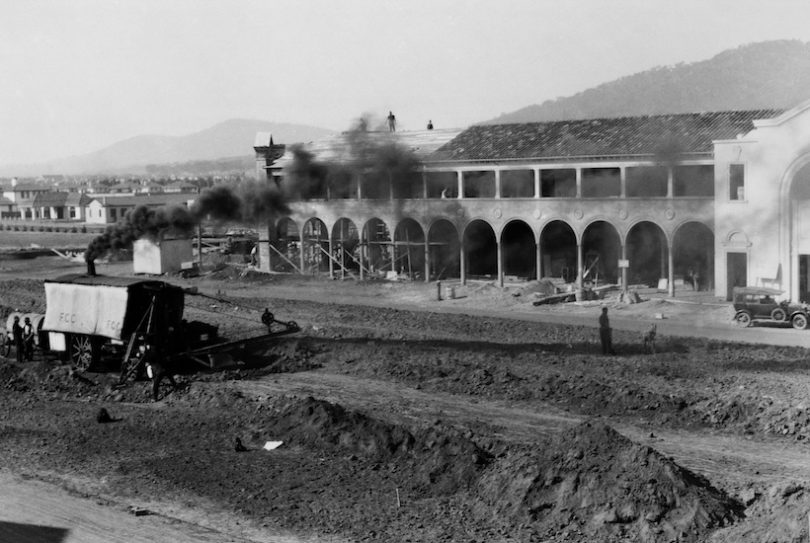
Part of the Sydney Building under construction in 1927 (a Keystone steam shovel is excavating Northbourne Avenue). Photo: National Archives of Australia.
As time progressed, the Sydney and Melbourne Buildings hosted grocers, butchers, fruit and vegetable shops, a bootmaker, Gloucester restaurant, Churchills Grocery store, Canberra Fish Café, Capitol Café and Leo’s White Gate Café (known as Leo’s Café).
Verity Hewitt’s bookshop, Canberra’s first ‘serious’ bookshop, opened in the Sydney Building in 1938, selling second-hand books. McGlades Jewellers, which is still in operation today, was located here in the 1950s. Other stores included Beard Watson’s Furniture store and JB Young Ltd.
Mr and Mrs ER Snow established a drapery business in 1927 in the Sydney Building on the corner of London Circuit and Northbourne Avenue. This became known as Snow’s corner.
In later years, Fletcher Jones was located on the site, and when it finally closed in 2012, it ended an era of the site being host to successive clothing stores for 86 years.
Over the years, both buildings have suffered damage from fires. In December 1950, what was described as the “biggest fire in the history of Canberra” destroyed part of the Sydney Building, while in August 1953 “the most disastrous and costly fire in the history of Canberra” destroyed over half of the western side of the Melbourne Building. The push then was on to rebuild in readiness for the February 1954 visit of the newly crowned Queen Elizabeth II.
More recent times have seen fire damage to Mooseheads in the Sydney Building in 2002 and from an explosion in a ground floor restaurant on East Row in 2014.
Shopping trends started to shift in the 1950s with alternative suburban shopping options such as O’Connor and Ainslie and Manuka and Kingston. When Monaro Mall opened in 1963, shoppers focused on the newer part of the city centre. Major shopping centres in Belconnen and Woden opened in the 1970s and Tuggeranong in the 1980s, further enticing people away from the Sydney and Melbourne Buildings. Today the building’s occupants include restaurants, pubs and nightclubs. The longest-running of these is the Charcoal Restaurant, formerly known as the Charcoal Grill, in the Melbourne Building.
In operation since 1962, it boasts being located in the “first separate titled tenancy to be built in the building”.
And what about Mrs Prowse who did all that cooking at the Blue Moon Café?
She was also the mother of eight children and they lived upstairs above the café. To have time out, she would walk to Manuka Pool for a swim and walk back in time to be ready to cook the first breakfasts of the day. The Prowses sold the Blue Moon Café in 1948 to a new generation of Greek migrants, Emmanuel Gerakiteys and brothers Spyros and Peter Cassidy, who continued to make a significant contribution to Canberra’s early days.











